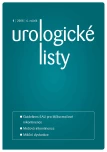Analysis of pharmacotherapy for female stress urinary incontinence
Authors:
J. Švihra; J. Ľupták; J. Kliment
Published in:
Urol List 2008; 6(1): 29-34
Overview
The International Continence Society defined urinary incontinence as the complaint of involuntary leakage of urine. Stress urinary incontinence (SUI) is the most common type of urinary incontinence in women. Approximately 300 thousands Slovak women over the age of 18 years have the symptoms of stress urinary incontinence. Pharmacotherapy often use duloxetine (an inhibitor of serotonin and norepinephrine reuptake) for the treatment of female stress urinary incontinence. According to the Cochrane analysis of ten randomized placebo-controlled trials 3 944 women received placebo or duloxetine 80 mg per day from 3 to 36 weeks. Despite the variation in the placebo response, duloxetine 80 mg per day was superior to placebo in all trials. The median percentage reduction in weekly IEF was 50–54% and was not influenced by previous treatment experience or baseline incontinence severity. Slovak clinical trial confirmed good clinical practice of duloxetine because total continence was reached of 3.2 % and incontinence improvement of 61.3 % cases.
Key words:
stress urinary incontinence, meta-analysis, duloxetine
Sources
1. Abrams P, Cardozo L, Fall M et al. The standardisation of terminology of lower tract function: report from the standardisation sub-committee of the International Continence Society. Neurourol Urodyn 2002; 21: 1670-1678.
2. Abrams P, Wein A. Introduction: Overactive bladder and its treatment. Urology 2000; 55: 1-2.
3. Hunskaar S, Burgio K, Diokno AC et al. Epidemiology and natural history of urinary incontinence. In: Abrams P, Cardozo L, Khoury S, Wein A. Incontinence. 2nd International Consultation on Incontinence. Plymouth, England: Health Publication 2002: 165-201.
4. Švihra J, Baška T, Martin M et al. Prevalencia ženskej močovej inkontinencie v Slovenskej republike. Urológia 2001; 7: 29-34.
5. Dúbravický J, Marenčák J, Moro J, Breza J. Odhad prevalencie inkontinencie moču a spôsobu jej liečby v náhodne vybratej vzorke dospelej populácie na Slovensku. Urológia 2002; 8: 1-11.
6. Avery K, Donovan J, Peters TJ et al. ICIQ: A brief and robust measure for evaluating the symptoms and impact of urinary incontinence. Neurourol Urodyn 2004; 23: 322-330.
7. Švihra J, Avery K, Sopilko I, Kliment J. Slovak version of a new questionnaire for urinary incontinence: the international consultation on incontinence questionnaire short form ICIQ-UI SF. Urológia 2004; 10: 34.
8. Patrick DL, Martin M, Bushnell D et al. Culturaladaptation of a quality-of-life measure for urinary incontinence. Eur Urol 1999; 36: 427-435.
9. Bushnell D, Martin M, Svihra J. Evaluation the performance of a new Slovak version of the incontinencerelated quality of life measure (I-QOL). 8th Annual conference of the International Amsterdam: Society for Quality of Life Research (ISOQOL) 2001: 283.
10. Švihra J, Baska T, Martin M et al. Prevalence of female overactive bladder with urinary incontinence in Slovakia. Eur Urol 2002; 1: 85.
11. Švihra J, Bushnell D, Martin M et al. Quality of life in stress urinary incontinent patients having surgery with tension free vaginal tape or intravaginal sling. Progres en Urologie 2004; 14: 13.
12. Michel MC, Peters SLM. Role of serotonin and noradrenaline in stress urinary incontinence. BJU Int 2004; 94: 23-30.
13. Norton PA, Zinner NR, Yalcin I, Bump RC. Duloxetine versus placebo in the treatment of stress urinary incontinence. Am J Obstet Gynecol 2002; 187: 40-48.
14. Yalcin I, Bump RC. Validation of two global impression questionnaires for incontinence. Am J Obstet Gynecol 2003; 189: 98-101.
15. Dmochowski RR, Miklos JR, Norton PA et al. Duloxetine versus placebo for the treatment of North american women with stress urinary incontinence. J Urol 2003; 170: 1259-1263.
16. Kerrebroeck P, Abrams P, Lange R et al. Duloxetine versus placebo in the treatment of European and Canadian women with stress urinary incontinence. Br J Obstet Gynecol 2004; 111: 249-257.
17. Millard RJ, Moore K, Rencken R et al. Duloxetine vs placebo in the treatment of stress urinary incontinence: a four-continent randomized clinical trial. BJU Int 2004; 93: 311-318.
18. Ramsay IN, Thou M. A randomised, double-blind, placebo controlled trial of pelvic floor exercises in the treatment of genuine stress incontinence. Neurourol Urodyn 1990; 9: 398-399.
19. Yalcin I, Bump R. The effect of prior treatment experience and incontinence severity on the placebo response of stress urinary incontinence. Neurourol Urodyn 2003; 22: 481-482.
20. Kerrebroeck P. Duloxetine: an innovative approach for treating stress urinary inkontinence. BJU Int 2004; 94: 31-37.
21. Švihra J, Ľupták J, Kliment J. Duloxetin verzus transobturatórna páska v liečbe stresovej inkontinencie moču u žien. Urológia 2006; 11: 14.
22. Mariappan P, Alhasso AA, Grant A, N´Dow JMO. Serotonin and noradrenaline reuptake inhibitors (SNRI) for stress urinary incontinence in adults. Cochrane Database of Systematic Reviews 2005; 3: 1-51.
Labels
Paediatric urologist UrologyArticle was published in
Urological Journal

2008 Issue 1
Most read in this issue
- Pelvic organ prolapse in women from the viewpoint of a urologist
- The Pathophysiology of Large Capacity Bladder
-
Kolposuspenze dle Burche – zlatý standard v operacích ženské močové inkontinence
Současná urogynekologická operativa I - Urological consequences of gynaecological surgeries
